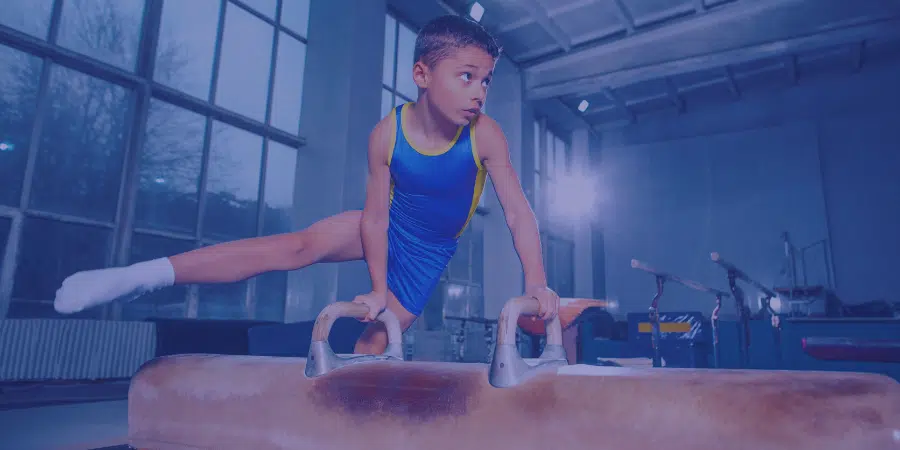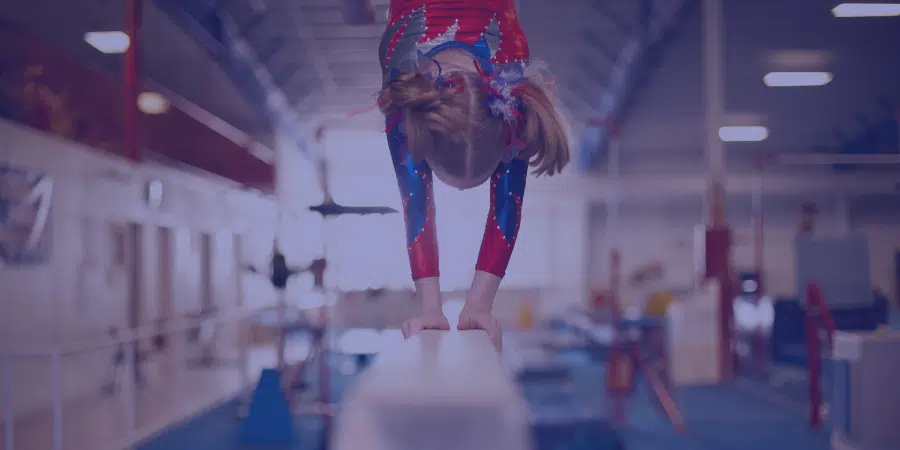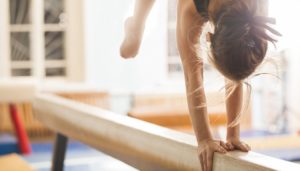Teaching gymnastics requires just as much flexibility as skin the cat on the rings or circles and flairs with spindles on the pommel horse. If your fitness or dance studio is adding teaching gymnastics to kids to your roster of classes, here’s seven tips to get started.
1. Safety Is Your Priority
Before you take the first step on the balance beam or start your run across the mat, focus on safety. Of course, you want your students to have fun and feel like they are progressing, but never at the expense of injury.
So, how can you make safety a (fun) priority when teaching gymnastics?
Take the time to explain to students why they need certain safety equipment when they are training. Focus on the benefit of proper alignment, strength, and conditioning and how these things can help them feel better and be more successful in their skills over time.
Even athletes at Olympic levels use safety equipment when training. This could be anything from wrist straps, guards, and grips to spotting belts and specialized footwear. Safe training means fewer injuries and longevity in the sport, at every level.
2. Focus On The Foundations
Related to safety, you should also focus on building a solid foundation before attempting complicated or physically taxing routines or movements.
Start by teaching basic gymnastics lingo and the associated actions so you and your students are literally speaking the same language. Examples include:
- Lunge
- Pike
- Hollow
- Straddle
- Tuck
- Forced arch
- Lock
You can also teach foundational gymnastics moves such as L-sits, cartwheels, rolls, and single balances. These may seem basic, but all beginners, regardless of age, need to learn them.

3. Build Your Gymnastics Curriculum
Once you have safety systems in place, your solid foundation is what you build your gymnastics curriculum on. Regardless of age, teaching gymnastics starts with a complete warm-up and goes from there.
Here are our suggestions for building your curriculum for younger and more advanced students.
Preschool gymnastics curriculum
A preschool gymnastics curriculum will focus on kids learning how to use their bodies and move around in space. As adults, we take for granted the simplest of movements, but even something like switching the cross of their legs when seated can be challenging for preschoolers.
Teachings gymnastics to preschoolers should be fun, engaging, and basic, designed for short attention spans and high energy. Choose quality over quantity. Don’t try to teach too much, and use music to help kids coordinate their uncooperative arms and legs.
You can use themed classes that build into a sequence kids can memorize. Maybe your lessons focus on building shapes with your body or moving like an animal. There are a variety of resources available online, including classes that don’t use props if your equipment is limited.
Experienced gymnastic lessons
For more experienced gymnasts, your lesson plans will be more focused on student goals and their level of expertise. As students progress with gymnastics, they may begin to specialize in certain pieces of equipment, but they will still need all-around skills instruction.
Most experienced students will progress at vastly different paces, so it’s crucial to get to know each student’s goals along with their strengths and areas for growth to properly design each lesson.
4. Set Professional Expectations
Professional expectations of the studio, the teachers, students, and their families are as important as a solid gymnastics curriculum.
These expectations establish ground rules for safety, conduct, and responsibilities to each other.
Insurance for studio owners
If you are a studio owner, you are morally, ethically, and legally bound to maintain adequate insurance coverage in the event of accident or equipment failure. This is more than just protecting the studio from loss.
Adequate insurance protects your students and the families you work with. Ensure you have comprehensive insurance coverage that matches your needs.
Insurance for solo teachers
If you are a teacher contracted by a studio to teach a set number of classes, chances are good you will need to provide your own insurance with the studio listed as an additional insured.
This insurance protects you against personal legal action and provides coverage for the studio as well.
Boundaries with students
It can be hard, especially when teaching gymnastics to younger students to avoid physical contact like hugs. But, setting good physical boundaries with students is important.
Encourage fist bumps, high fives, and elbow bumps to keep things encouraging and professional.
Building relationships with families
Yes, it’s true that some families are challenging to work with. Keep in mind that you are all coming together in what’s best for your student. It helps to have clear guidelines for parents in terms of observing lessons, asking questions and contributing to training. These guidelines can be part of the enrollment process. You can also place signs in appropriate areas to remind families of how you can best work together.
On the other side, there should be a clear system for parents to give feedback about lessons and instructors without fear of reprisals for their kids. Everyone wants a solid gymnastics program that is fun and rewarding.
5. Build Fun Beginners Gymnastics Lesson Plans
After safety, fun should be the number one priority of beginner gymnastics lesson plans. Keep these things in mind.
Group kids by stage of development
When kids are younger, grouping by age is appropriate, but as they get older, skill level is the defining factor.
Your studio can still offer open classes with all ages mixed together, but specialized classes by skill level offer more chances for success and growth.
Keep classes fun
Sure, your kids will want to work hard to see progress, but that shouldn’t get in the way of fun. Except for safety, don’t offer too much correction during class.
Pick a few things to stress per class and let the rest go. Bring in some funky music and be encouraging. Dance through the warm up, and let kids pair up for activities when possible.
Plan carefully
Certain moves may be too challenging for students. Plan alternatives that are available to all. Some days your students will feel low energy or less flexible.
Alternative moves are a good way to accommodate everyone in class.
Have equipment ready
If you need to modify a lesson or want to teach a new skill, make sure you have the right gymnastics equipment handy. This includes:
- All necessary safety equipment
- Flooring
- Mats
- Tools and apparatuses
- Accessories
Minimize wait times
If you can have multiple activities going on at once, this minimizes wait times and keeps kids engaged.
Older gymnastics students may be able to help coordinate this for younger students, or you can set out self-directed activities at individual stations.
Don’t ignore discipline
It’s a fact that cannot be ignored: some students will get out of line and need disciplinary action. Ignoring a student who interrupts, is rude, or jumps the line is a recipe for disaster.
Work to prevent problems by recognizing and commenting on positive behavior while planning your disciplinary strategy when issues (inevitably) crop up.

6. Become A True Coach
What makes a true coach?
- A true coach knows how to motivate and encourage gymnasts without focusing on winning or praise
- They know they are developing character as much as a back handspring
- True coaches are tough but fair
- True coaches care deeply about their kids but maintain appropriate boundaries
You can recognize a true coach by their obvious dedication to their students, along with their commitment to preparing them safely and properly for whatever challenges they encounter, both on the mat and off. Whether you’re a studio owner who is developing this skill in your teachers, or a single teacher, build time into your schedule to work on coaching skills.
7. Get Help When Teaching Gymnastics
When it comes to teaching gymnastics, you’re the professional. For the other half of running a successful business, like enrollment, billing, and more, we’ve got you covered. The Studio Director is a comprehensive gymnastics studio management software that automates your key business tasks so you can focus on your students.
We leave teaching gymnastics to you; leave the rest to us. Get in touch for a demo today.


